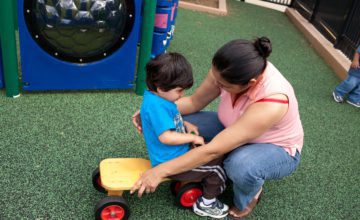By Claire Lerner
You’ve probably noticed by now that your 18-month-old is an eager imitator! Browse the information and links below to see what your little one is experiencing and learning this month.
What It’s Like for You
You’ve probably noticed by now that your 18-month-old is an eager imitator. He delights in copying what he sees you do. And now that he is talking more, he will also imitate what you say. This can lead to unbelievably cute “repeats” from your little one…and some embarrassing ones too. Shares Jayson, father of Eli (18 months):
I was in some bad traffic and another car cut me off. I cursed without thinking about Eli being in the back seat. We got to my in-laws’ house and sat down to dinner. Eli got ketchup all over his shirt and he looked up and loudly repeated the word I had used earlier. It was really awkward. My wife saved the day. She said, Mom, it’s not what you think. The baby wants a fork. Luckily, they rolled with it and nobody said anything more about Eli’s little ‘slip.’ But I learned my lesson and I’m a lot more careful now about what I say.
Because children look to us for cues about how to act, when we have a strong reaction to something—and use a curse word, for example—they make note of it. The stronger the reaction, the more likely our child is to use that word again because he knows that it will definitely get some attention from you. So if you ever hear an R-rated echo from your toddler, try to keep your face still (neither angry nor giggling) and just ignore it. No response or attention from you? Then there’s no motivation to say it again. This strategy of ignoring behavior you don’t like can be helpful in many situations.
What It’s Like for Baby
I am playing with the shape-sorter again. I keep trying to figure it out. I can get the circle shape in the circle hole and I can get the square shape in the square hole. But I am having trouble with the other two shapes. Mommy says, The triangle and the star sure are tricky, aren’t they? I just cannot get them in their spaces! I am getting really mad. WHY won’t they fit? Mommy says, Try turning the triangle around (as she picks up one of the pieces and turns it in her hand). Then I think it will fit in the hole. I try to do what Mommy says, but it still won’t work. I hate this toy! I throw the star and the triangle right across the room. Mommy says, This toy is hard to figure out—that can be really frustrating. But you can’t throw things. She tells me to go pick them up and that she’ll help me. She asks me which one we should try first. I pick the star. Mommy says, Okay which hole should we try? I point to one, and she puts her hand over mine and we try to put the star in. It doesn’t fit. I start to get upset again. Mommy says, Hey let’s not give up. There’s still one more hole to try. So we try the other hole and what do you know? It fits! Then we drop the triangle in too. Mommy smiles at me: See, I knew that we could figure it out! I give her a big hug. I did it!
What Your Toddler Is Learning
Social-Emotional Skills:
- To cope with frustration
- To express strong feelings like anger and frustration
- Self-control when she has to pick up the pieces, taking responsibility for her actions
- Self-confidence that she is smart and capable and can figure things out
- How to accept help and learn from others
Language and Thinking Skills:
- Words for colors and shapes
- Words for emotions like frustration, upset, tricky, etc.
- Problem-solving strategies, like trying the same shape in different holes to find where it fits, and moving the block around so that it is lined up to fit it in the hole
Physical Skills:
- Fine motor skills as she uses the muscles in her hands and fingers to pick up and work with the blocks. Fine motor skills are necessary for learning how to write later on.
What to Expect From Your Baby’s Development
As you review the chart, keep in mind that development is not a race and that every child grows at her own pace and in her own way. Your child may develop skills faster or slower than indicated below and still be on track. If you have questions or concerns, talk with your child’s health care provider or other trusted professional.
Your Toddler’s Development From 18 to 24 Months
| What Your Baby Can Do | What You Can Do to Connect With Your Baby |
|---|---|
I am learning new words everyday. |
|
|
|
I can use my hands and fingers to do so many new things. |
|
|
|
I am learning about my own and others’ feelings. |
|
|
|
I am beginning to use my imagination. |
|
|
|
I am a little scientist, always testing things out! |
|
|
|
Did You Know…
That 18-month-olds are now able to understand that what others want may be different from what they want? The researchers determined this by showing both 14- and 18-month-olds a bowl of Goldfish crackers and a bowl of broccoli. When given a choice, both groups chose Goldfish crackers to eat. Then a researcher tasted each of the foods. She said, ”Yuck” and made a face when she sampled the crackers, and said, “Yum” and smiled when she ate the broccoli. The researcher then asked the toddlers to give her some food. The 14-month-olds handed her crackers, presumably because they could not understand how anyone might want or desire something other than what they did—the crackers. However, the 18-month-olds handed the researcher broccoli. This showed that, while they preferred the crackers, these older toddlers “got” that the researcher liked the green stuff best.
What the Research Means for You
At 18 months, children begin developing a sense of self-awareness—the knowledge that they are individuals with their own feelings, thoughts, likes, and dislikes. Then they realize that other people have their own feelings, thoughts, and preferences, too. They can imagine how another person feels in a certain situation. You can help your child develop this emotional understanding and social awareness by:
- Talking about others’ feelings. Kayla is feeling sad because you took her toy car. Let’s give Kayla back her car, and then choose another one for you.
- Suggesting how children can show empathy: Let’s get Jason some ice for his boo-boo.
- Putting yourself in your child’s shoes. That doggy is barking really loud. That can be scary. Would you like me to hold you until he walks by?
- Explaining differences. Randy doesn’t like going down the big slide like you do. Everyone is different and likes different things, don’t they?
Spotlight on: Making Literacy Part of Every Day
Now that your toddler is walking and running, sitting on your lap listening to stories may no longer be high up on her list of favorite things to do. This is totally normal and nothing to worry about. As children enter the toddler years, they delight in what their bodies can do—walking, running, jumping, bouncing, rolling, sliding. Sitting still to hear a story just may not feel very fun right now.
So, if you can’t beat ‘em, join ‘em. Instead of expecting your child to always sit down to read a story, follow her lead and build reading into activities she enjoys even while she’s on the move. In early childhood, what’s most important for developing literacy skills is a love of books. It doesn’t matter whether your child reads a book upside down, only wants to read the same two pages over and over, or is doing somersaults as you read to him. He’s still developing literacy skills.
To combine your child’s love of moving and love of reading:
- Choose books that feature interesting actions or movements. For example, there are several storybook versions of the song “Wheels on the Bus” that can be great fun for you and your child to act out together. Also, action books like “Barnyard Dance” can be a wonderful way to expand your child’s vocabulary of verbs and adverbs.
- Tell a story to your child. That way, your child can be playing and moving around while still having the experience of hearing a story and spending time with you. And you don’t have to be Shakespeare to tell good stories. You can tell or adapt stories from your daughter’s favorite books, or pull from your own childhood exploits. Toddlers are also beginning to grasp the idea that they, themselves, were once babies. You’ll find that your daughter may love to hear about when she was teeny-tiny, Once upon a time, long ago, when YOU were a baby….
- Sing with your child. You can nurture your child’s love of words, sounds, rhythm, and rhyme through singing and music as well. Look for songs that are good for dancing, marching, bouncing, and spinning. Your child can also act out the song while you sing—for example, your child can call out different animals for Old MacDonald’s Farm and then pretend to be each one.
- Experiment with tools for writing. What are stories but a collection of words and pictures? Give your child the chance to experiment with different writing materials: markers, pens, crayons, paint, pastels, etc. This helps toddlers build the fine motor skills they’ll use later to write. It’s also fun to watch toddlers as they become more skilled with writing and drawing—and creative, too.
- Play with letters. Look for letter magnets, stickers, or blocks that your child can arrange and rearrange to his heart’s content. You can spell things out for him. Then you can knock these “word towers” down, and start over.
- Pretend with your child. Play out a sequence of events such as going on a picnic, cooking, and serving dinner, or having a “just pretend” birthday. These are all ways of telling a story. Stick to short periods of time. Let your child decide how much (or how little) time you spend reading. And you don’t need to read every page. You may find that your child has a favorite page or even a favorite picture. She may want to linger there for a while, and then switch books or activities. When you let your child explore books in the ways that interest her, books become a source of pleasure.
- “Read” the pictures. You don’t have to read the words to tell a story. You can simply describe the picture in your own words. When your child is old enough, ask her to read the pictures to you! Let your child turn the pages. This gives your child a sense of control as well as a job to do.
- Make the story come alive. Create voices for the story characters and use action to tell the story. See if your child is interested in acting out parts of the story, hopping like the frog or dancing like the princess.
- Create stories from your child’s daily exploits. Tell your child the story of his day. This helps him understand his world and how he fits in. You can also snap photos of your child during his daily routines—like eating breakfast, getting dressed, washing hands, and brushing teeth. Glue these photos onto pieces of construction paper and tape or staple them together. You’ve made the story of “My Child’s Morning.” Children love reading and hearing stories about themselves most of all!
- Get some “characters” to help you read. Read or act out stories using inexpensive homemade paper bag puppets. Or have one of your child’s favorite stuffed animals read the story to her. Play games with words. Write an action your child can do (“kick a ball” or “walk to the kitchen and come back” or “give me a hug”) on index cards. If you can find a picture to match the action, even better. Put them in a hat and ask your child to pick one. Read it out loud and let her do the action. Take turns picking and doing.
Naturally, as your child continues to learn and grow throughout her early years and beyond, her interests will change. You may find that in a year or so, as she really begins to grasp the concept that letters are symbols for sounds, words, and ideas, she will be positively fascinated with reading and books. In any case, whatever her interests, the key is to find creative ways to support her love of books and reading through all her developmental stages.
Let’s Play: Activities That Nurture Bonding and Learning
Glue is Good
Make a collage with your toddler by cutting out magazine and catalog photos of children, dogs, houses, and bicycles. Add some textured paper—like squares of aluminum foil, sandpaper, tissue paper, etc. Then squeeze a puddle of glue onto a paper plate and let your little one go wild with dipping and sticking pictures onto a big piece of heavy paper.
Create a Construction Site
Collect sturdy cardboard boxes of all sizes, from shoebox to shipping box. Tape the tops closed and let your toddler construct supersized castles or other structures. Snap photos of him as he’s just beginning his play, while he’s building, and again with the finished product. Print these photos out and glue them side by side on a piece of construction paper. Post it where your child can see it. As the two of you talk about the photos, your child will learn concepts like before/during/after and cause and effect.
What’s on Your Mind?
1. My 18-month-old son naps at child care like clockwork, every day from 12:30 to 2:30 pm. But on the weekends we can’t get him to go down for even 30 minutes! We do his nap routine, put him in his crib, but he screams until we give up and go get him. By 5 pm we’re all exhausted. Any suggestions?
It can be tough to have a toddler up all day, especially one who is cranky and overtired. And no naps mean no breaks for Mom and Dad. It can also feel pretty frustrating for parents to know that their child is a dream at child care but won’t go down without a fight on the weekend. The comforting news is that this dilemma is pretty common. Here’s why.
First, child care providers are dealing with children in groups, so there is a greater need for rules and cooperation than there is at home. And children are amazingly adaptable. I remember my own surprise at learning that my 2-year-old, who hadn’t napped since she was 15 months, played quietly with toys and books for an entire hour and a half most days at child care and sometimes actually fell asleep!
Second, there is a difference in the nature of the adult-child relationships in child care versus home. A child care provider may care deeply about your son but she does not have the same emotional connection to him as you do. This is why parents almost always find it harder than child care providers to set and enforce limits. Parents have a tendency to get love and limits mixed up, feeling they are doing something wrong by setting a limit their child protests. For working parents, enforcing a naptime can be an especially tough limit to set because it means another separation from their child (if only for an hour or two) and loud, unhappy protests.
The first step is to know that you are being good parents by helping your child get the sleep he needs, even if he cries and complains. Keeping this in mind will help you follow through on a plan. Start by talking with your child care provider to learn how she helps the children transition to nap time. Is there lunch, then diaper changing, then a story? Does she rub your son’s back? Dim the lighting? Is there music or any other ambient noises? Try to re-create the atmosphere and rituals as much as possible at home. Also keep in mind that a real nap-killer on the weekends is changing your son’s routine. Falling asleep in the car for 15 minutes here and there (as many kids do while parents run errands) means he may not nap when you get home. And if you let your son sleep later on a Saturday or Sunday morning, he may not go down at nap time. So try to keep to your child’s usual schedule as best as you can.
When you put your son down for a nap, put a few soft toys or padded books in his crib. Some toddlers need time to wind down or, after napping, time to wake up; quiet play can often do the trick. (This is not recommended for babies under 12 months for whom soft objects in the crib can be a suffocation hazard.)
If your son cries, go in to comfort him briefly—but don’t linger or take him out of the crib. Give him a cuddle and explain, It’s nap time now. You can decide if you’d like to go back in at subsequent intervals (say, 5 minutes or 10 minutes later if he’s still crying) or not at all. The approach you choose depends on your baby’s temperament and what you feel might work best for him. The going-in-periodically-to-soothe routine not only didn’t calm my 9-month-old son, it confused him, made him angrier, and prolonged the protesting.
Remember, this is a learning process and takes time. Start out with a half-hour as a goal. Put him down, go back in as you’d like. Then, if he doesn’t fall asleep, go get him after a half-hour. Wait a few days, then shoot for 45 minutes, then an hour. Soon you may find that he is learning to fall asleep on his own.
The most important thing is consistency. Going in and picking him up one day, then letting him cry it out the next is not likely to work and will only confuse your toddler. When you are consistent with his napping ritual, he will learn to adapt more easily and quickly.
2. My 18-month-old has loved up her stuffed bunny so much that it’s literally falling apart—and it smells bad! I want to get rid of it, but I’m worried about how my baby will react. I can’t find another bunny that’s exactly like it to replace it. Is there a way to get her to prefer a new toy of a different stuffed bunny?
Imagine how you would feel if someone said they were going to take away your beloved spouse/partner/best friend (falling apart and bad smelling or not!), and get you a new, improved version. Now you know how your child might feel if you replace her treasured bunny!
“Loveys,” especially those that are smelly and worn, are very special for children. They are a substitute for when they can’t have you. Children are so attached to them because they invest in them all the love and security they feel with you. So when they can’t have you, they have the next best thing, their beloved lovey! As you’ve probably seen, your daughter’s bunny helps her cope during stressful or scary times, comforts her when she has a boo boo, gives her something familiar to rely on when she is feeling overwhelmed, and provides support during daily transitions such as going down for a nap. Also, as your child grows and begins to use words, sometimes her bunny will help her express her feelings and emotions. She may tell you why the bunny is scared to go to preschool or why the bunny no longer wants to sleep in his room at night by himself.
My suggestion is: Don’t get rid of it. It is serving a critical role in your daughter’s ability to cope with life’s challenges. And it is highly unlikely that any replacement will do. When my son was about 9 months old, we left his lovey—an elephant—on a plane and bought him the exact same one when we realized it was gone. He immediately stroked its trunk (which had already worn thin on the original), realized it felt different than his lovey, and promptly threw it across the room.
If you do decide to phase out your child’s bunny, here’s what you can try:
- Suggest that bunny needs a bath and let them take a bath together. It may not have the same effect as the washing machine but it might be an improvement.
- If you are concerned that bunny may fall apart, suggest that bunny may want a friend. Go to the store and let your daughter choose the friend. Then include the new “friend” in as many ways you can (when you read books and sing together, when you comfort your child, as company on a car ride, etc.) so that hopefully the feelings your daughter has for bunny will transfer to the friend. Then this friend can serve as a substitute when and if bunny does fall apart, although it is more likely that she will simply choose to carry bunny’s disembodied ear around rather than accept a replacement.
- Let your child help you as you carefully stitch up bunny. Talk to her about the importance of taking care of herself and others and use it as an opportunity to start showing her what empathy is all about.
When is it time to say good-bye to loveys? When your child is ready. My experience is that if you don’t interfere in their “relationship” and force a separation, children gradually separate on their own. By the time children are school age, the loveys become less central in their lives and usually stay in their beds for nighttime comfort. My kids—now 15 and 17—still have their loveys in their beds and still have very warm, special feelings toward them. (We actually found my son’s original elephant.) They serve as comforting, very positive symbols of their childhood.
3. My 18-month-old refuses to brush her teeth. We have a power struggle every morning and at bedtime. What can we do?
This is a very common problem among toddlers. The key to solving it is finding out what’s causing your daughter’s resistance. Is it that she’s trying to assert some control? Most children her age will protest anything they know is important to their parents. What better way to feel powerful at a time when kids have so little control over so many aspects of their lives. Another possibility is that your child’s gums, teeth, and mouth are sensitive and tooth-brushing actually feels irritating to her. Or, perhaps she doesn’t like the smell or taste of the toothpaste. Children who have this kind of oral sensitivity also tend to have other tactile issues such as finding certain clothes uncomfortable and itchy, and disliking seams on their socks and tags in their shirts.
If you suspect your daughter is just asserting her independence, forcing the matter probably won’t work. You need to find a way to offer your daughter some measure of control, but still get her to brush. It can help to give her some choices: let her decide from among a few different kinds of toothpaste or choose her own toothbrush. You can also allow your daughter to decide at what point in her bedtime routine she wants to brush.
Teaching your daughter about consequences can work too. Tell her if she brushes like a big girl and doesn’t put up a fight then you will have time to read an extra book before bed. Or let her know that if doesn’t brush her teeth, she won’t be allowed to have any sweet snacks, because not brushing means the sugar in sweet treats remains on the teeth and can cause cavities.
If you suspect that an oral sensitivity to brushing is the issue, then you may need to try a different way to get your daughter’s teeth clean. Amy Light, a pediatric dentist in the Washington, DC, area says that all toddlers need for good oral hygiene is some kind of washing and stimulation of the teeth and gums after meals and before going to sleep. Your daughter doesn’t have to use a toothbrush or toothpaste. You can clean her teeth by using your clean finger, a tooth finger brush (it fits over your finger), or a washcloth to wipe away the plaque and food residue on her teeth. If your child is sensitive to the taste and smell of toothpaste, you can get flavorless kinds in most pharmacies.
Expert Reviewers
- Terrie Rose, PhD, President and Founder, Baby’s Space
- Ross Thompson, PhD, Professor of Psychology, University of California at Davis
- Robert Weigand, MS, IMH-E, Director, Child Development Laboratory, Arizona State University





